

A life well Dunn, and strapping on the ol' feedback
 |
Mike Dunn’s Final Take column that accompanies National DRAGSTER’s Pro coverage from the NHRA POWERade Drag Racing Series national events is one of the most popular weekly features in the magazine, and it’s always fun talking to Mike to prepare those articles. Basically, I call him each Tuesday night, and we bench race like old buddies for an hour to decide what the content should be. I can pick his brain for things that intrigue me, and he is always meticulously prepared with notes and observations. He has so much knowledge of all sides of the engine – from in front, behind, and inside – that there’s little he can’t address, and in a relaxed, conversational manner that makes it clear he’s talking to you, not down to you.
I was a Mike Dunn fan from way back anyway – probably after seeing him kick ass in bicycle drags in Funny Car Summer – and growing up in SoCal, I got to watch him learn the nitro ropes with his dad, “Big Jim” Dunn, Roland Leong, and Joe Pisano. Being able to talk to him on a regular basis has done nothing but increase my admiration. His work as a color commentator on the ESPN2 shows is first-rate, and, as he’s shown in brief guest stints in people’s cars lately, he hasn’t forgotten anything about driving, either. I’ve been hanging on to this wonderful photo of Dunn for a few years; it was shot during one of the Phoenix test sessions as he was explaining to me the massive acceleration of the fuel cars; I looked like a real goober in this photo, so I mercifully cropped myself out.
He’s not just a nitro guy, either; he has a great appreciation for the Pro Stock guys. The fact that Pro Stock cars have run in the 6.50s and that he earned his nitro Funny Car license in May 1977 with a 6.53 brings that home for him.
“I licensed in my dad’s car, which at the time was the Dunn & Velasco Satellite,” he said. “We actually ran it on alcohol first the year before; we had a 6-71 blower and a small injector, and my dad blocked off the port nozzles and bought an alcohol barrel valve. My dad had a spare two-speed, so I spent $600 of my own money to buy a kit that was out there that you could use to bolt together two two-speeds to make a three-speed. My dad was messing around with the Donovan then, but he didn’t want me to ruin his good parts, so he found an old steel Hemi. Pisano gave me a set of pistons and a camshaft, and Valvoline gave me a drum of alcohol. I ran 7.38 at 178. We switched to nitro for a race at Orange County, where I got my nitro license and even qualified for the show. It was kind of funny because he actually was struggling at the time with that Donovan, and I went quicker than he’d run in a while.”
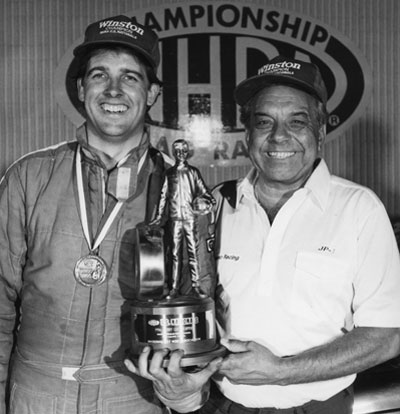 |
The fun ended there, though, as he broke a rod on his first-round burnout against Dale Pulde, and after “Big Jim” made it clear that Mike wouldn’t be handed a race car of his own, he left to crew for Leong through the end of 1979 before landing his first ride, in Bill Schifsky’s Beartown Shaker, replacing Rick Johnson (who would wheel Leong’s Hawaiian after Dunn). He began piloting Leong’s Hawaiian in 1980 and drove for the fabled car owner for four seasons – and through two terrifying 1983 fires, in Columbus, Ohio, and at Orange County Int'l Raceway – and apparently both felt that a change of luck was due for them.
After a brief stint in Greg Artz’s low-dollar Nighthawk Charger, Dunn landed perhaps his most famous ride in Pisano’s gorgeous series of Oldsmobiles. He won several events, including the U.S. Nationals in 1986 (pictured), and set the national speed record. He drove for Pisano through 1989, then teamed with his dad and Pennsylvania businessman Ed Abel on a car sponsored by Snickers.
In 1993, Dunn began an eight-year association with Darrell Gwynn and crew chief Ken Veney in a series of Top Fuel dragsters with solid backing from companies such as La Victoria Salsa, Mopar, and the New York Yankees. He retired after the 2001 season after being replaced in the Yankees car.
All told in his driving career -- so far – he won 22 national events – 12 in Top Fuel and 10 in Funny Car – and reached 40 final rounds, 27 in Top Fuel and 13 in Funny Car. He's one of only four drivers in NHRA history to record at least 10 wins in both nitro classes, accompanied by Don Prudhomme, Kenny Bernstein, and Gary Scelzi. That's some pretty good company.
In addition to his current broadcasting gig, Dunn coaches some of NHRA's new young talent – some publicly, some privately – and with wife Sandy also cheers his 12-year-old son Michael from the sidelines as he continues to make quite an impression on Pennsylvania youth baseball. The Dunns' daughter, Samantha, whom we watched grow up at the track in the early 1980s, is now 25.
A life well Dunn, Mike.

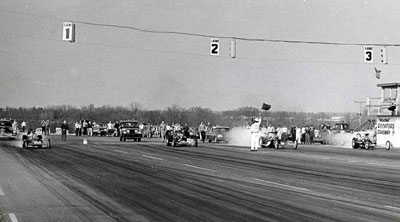 |
Mark Pieri’s tales of four-lane racing at Rockford brought in a deluge of mail from people with similar memories from across the country. Domenic Paris, son of former Top Fuel racer Rico Paris and a good friend of Pieri, passed on this pic, which he believes is from the same weekend at Rockford Dragway as Pieri’s pic.
“I was maybe 6 or 7 when this photo was taken, but I remember it like it was yesterday,” he wrote. “My father is in lane one, and I do know the flagman was Bill Middaugh, currently with Primedia and still involved with racing. The Paris family would also like to express our thoughts and prayers to the family and friends of Ron Correnti.”
You can view a bigger version of this pic here to get a real feel for the fun.
Former National DRAGSTER Editor Bill Holland also remembers seeing four Top Fuel cars race in Fresno, Calif., back in the 1960s.
“I remember Dwight Salisbury telling me that it was kind of a ‘team’ deal with the two cars in the right lane versus the left lane. This led to a little skullduggery, where one of the two cars would lag in the staging beams while the other was free to jump the gun. He learned his lesson from Kenny Safford, a longtime friend. I believe they were both in the Bel-Airs car club in Glendale. The helmet Dwight wore when he first started driving T/F was a Safford hand-me-down. Both great guys!”
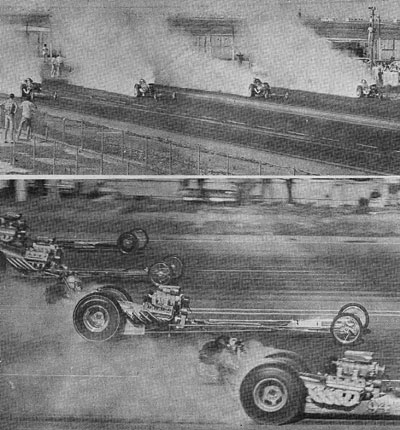 |
Stephen Justice backed up Holland’s memories with a newspaper article and these photos from a May 7, 1967, four-car match at Fresno. At the event, the track’s inaugural Golden Nationals, Gotelli & Safford were teamed with the Syndicate II team while Jim “the Lizard” Herbert was paired with the Berry Bros. and Claude Stark. The format awarded points for first- through fourth-place finishes in three rounds, with first place getting four points, second three points, third two points, and fourth a single marker.
Safford-Gotelli won the first round, ahead of Berry, Herbert, and the Syndicate, which broke the rear end and was replaced in round two by Salisbury, at the wheel of the Armenian dragster. The results were identical in the second round, so the teams were tied at 10 points apiece. Herbert won the third round, ahead of Stark, Safford, and Salisbury. The final score was 17-13 for the Herbert and Berry Bros./Strark team.
Can you imagine John and Ashley Force going at it alongside Ron Capps and Gary Scelzi, four abreast like this? The line forms behind me!
Justice also remembered Fontana Drag City running four jet dragsters at the same time (Doug Rose in Art Arfons' Green Monster, Lucky Harris in Malone's US-1, J.D. Zink in Romeo Palamides' Untouchable, and Al Biscay in Palamides' Untouchable Twice; thanks, Bill "Billynitro" Holt) in 1965, a sighting confirmed by reader Kevin Hardy, who recollected, “My brothers and I parked along Foothill Boulevard to where you would be looking straight down the track to watch. When the jet cars left the line, there was so much dust and dirt, a couple shut off due to not being able to see.”
Chuck Rearick raced a Jr. Fuel dragster at Rockford and Great Lakes Dragway back in the 1960s when they were mixed with the Top Gas cars. With four cars hitting the strating line at the same time, confusion sometimes reigned. “With push-start cars from the big end, it always got interesting with four cars trying to make the turnaround in the staging area,” he recalled. “What made it more fun is we did not have reversers, so the crew had to pull us back and forth to get us lined up. You also had to keep in mind that it was a four-lane racetrack, because if you forgot and kept it in the center of a two-lane track, you took out the lights … which Ron Leek tried to charge us for.”
Vic Raupe of Guthrie, Okla., remembers seeing four abreast at fabled Green Valley Race City in Fort Worth, Texas, in the mid 1960s. “Because of the huge number of mid-‘60s muscle cars, track owner and great promoter Bill Hielscher used the superwide track for four cars at a time,” he wrote. “This made for more time trials and an early end to eliminations to meet curfew hours. I remember one Saturday night, there were so many Chevelle SS396s, GTOs, and others of this era that in eliminations three cars would lose and one would return for the next round.”
Floridian Wayne Albert also was told of four-lane racing at Miami-Hollywood Speedway, using the staging lanes that were parallel to the track. Jim King of Lodi, Ohio, also reports four-lane racing in the long history of Dragway 42 in West Salem, Ohio.

Apparently my worship of the Warren & Coburn team is not a solo endeavor, as my mailbox was flooded with memories of the dominant West Coast Top Fueler of the 1970s.
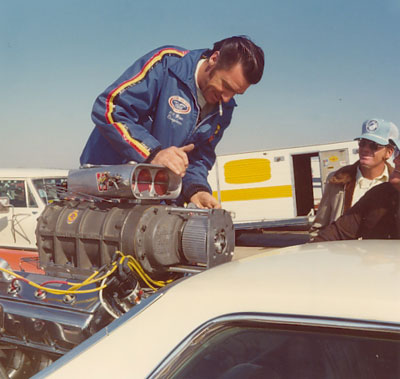 |
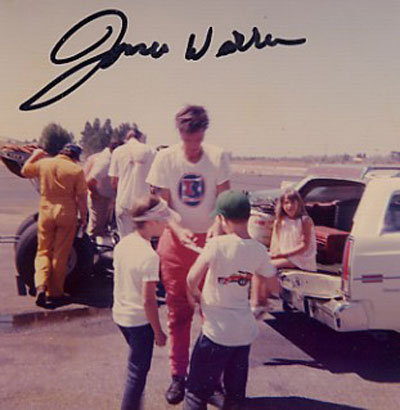 |
Reader Rick Lind remembers them well. “To this day I can still see Roger's white station wagon, the Mr. Ed trailer with the front of the car halfway in, and James and Roger in their white pants and shirts next to the staging lanes at The County,” he wrote. “If I'm not mistaken, I seem to remember Roger driving over the front of Don Durbin's car at The County one weekend with the station wagon.”
Steve Justice passed along this great pic of Roger Coburn at the 1975 March Meet, the first year that the W&C team won its big hometown event. "Roger showed up with a spare bullet tightly secured in the back of this Ranchero, which is what was used to push the dragster," he said. "Roger Coburn was so nonchalant. I never saw him get pissed off or angry; one could always talk to him.”
Noted metal fabricator Bill Gathings wrote, “My brother and I were huge fans of Warren-Coburn. I still have a collection of photos, magazines, a couple of the large garage posters, etc. In fact we hung around so much when Mark Prudhomme drove the car in '79-81 they had us help out and ride in the truck a number of times. How I wished I could have had the finances to really help at the time. The March Meets of '75-77 were like no others. Imagine a hometown team running on a shoestring budget out of a tiny garage, a trailer the car barely fit in, pulled with a station wagon, taking on a 32-car field of some of the finest including Garlits, and winning it all while setting track records in the process and then doing it three years in a row."
Gathings also says he’s interested in restoring the '75-77 W&C Woody Gilmore car – “Restoring rear-engine dragsters hasn't really caught on much, but believe me, this is THE car a lot of people would like to see on display out at the Bakersfield track,” he said -- so if anyone has leads, drop me a line, and I’ll pass it on to him.
Dale Smith – “one of the many pit rats running around OCIR,” as he described himself -- passed along this great pic of him and buddy Tim getting an autograph from Warren in front of the aforementioned white station wagon. He brought it to the California Hot Rod Reunion a few years ago and had Warren sign it. “How amazing, I mentioned to him, you autographing a picture of you giving me an autograph.”
“I also love how you brought up the part on operating out of the Mr. Ed trailer they had. Reading about it made me compare to helping [nostalgia Top Fuel racer] Brendan Murry. Yeah, his trailer is a bit bigger, but still it’s a 36-foot gooseneck and is just big enough to fit the dragster in it and pile all the stuff around it. [Pat] Foster said that Brendan is ‘THE’ throwback fuel racer, doing it like it used to be done. “
Interestingly, Smith makes nostalgia Satellite Funny Car bodies using a mold he pulled from an old Mr. Ed body (the ex-Tim Beebe entry). I’ve been trying to track down Ed Wills through Art Whipple, but no luck yet. In addition to his trademark trailers, Wills was apparently the lone supplier of Satellite bodies back in the day. If you’re a fan of ‘70s Funny Cars (and who isn’t?), you know that there were a ton of them out there, including Jim Dunn, Twig Zeigler, Dale Armstrong, Mike Burkhart, King & Marshall, the Alabamian, Rat Trap, Pusch & Cain, and Shirley Muldowney (the car that was destroyed by fire at the 1973 Nationals).
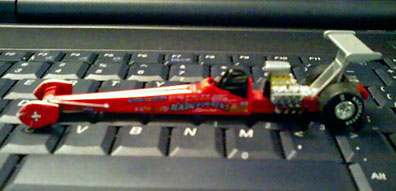 |
As much as I've talked about and written about (and been written to) about the Warren & Coburn car the last week, I forgot that I had a small version of it sitting right here in my office, on the window ledge next to my desk (I don't really keep it on my keyboard; that's what we call "dramatic effect" in the business). It's one of the collection of Johnny Lightning/Playing Mantis "Legends" series from 10 or so years ago. I also have the L.A. Dart wheelstander, "Big Daddy's" 250-mph car, and "Jungle Jim's" red Monza. Hell, I could stage my own nostalgia race.
As you know, if you've been around this candy shop of a column long enough, I'm still just a big kid who loves playing with small cars. The big ones are kind of cool, too.



















































